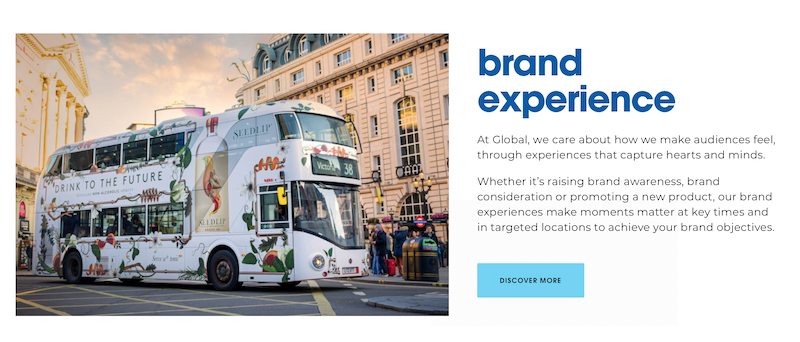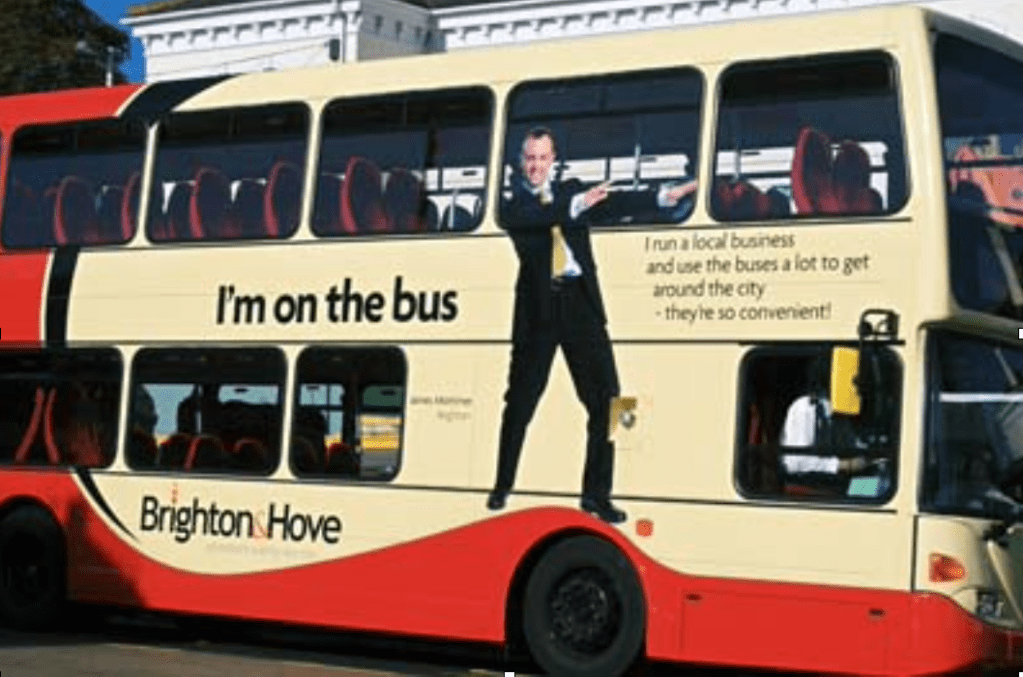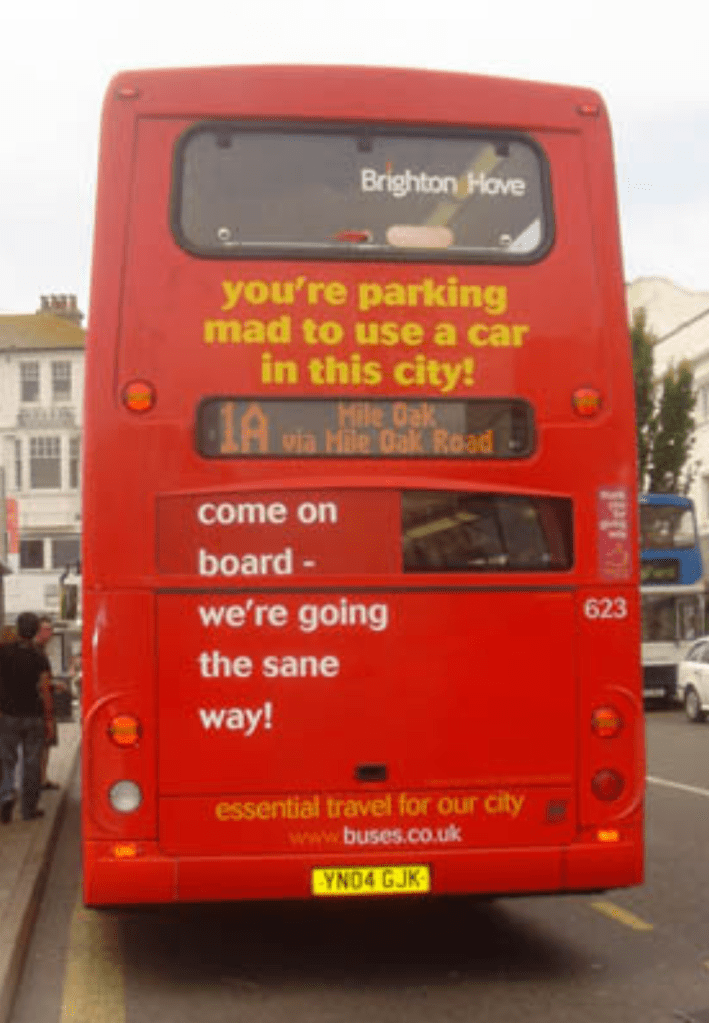How that campaign should have looked
Friday 3rd September 2021
Instead of this….

This….

This week’s controversy over Channel 4’s national advertising campaign for Naked Attraction using T shape bus sides in major cities around the country reflects more on the attitude of media giant Global who signed off the campaign and those bus companies who abrogate responsibility for how their buses present themselves than the programme publicists at Channel 4 who devised the advert.
The campaign was swiftly pulled after a storm blew up on social media as soon as the adverts began appearing on Monday. What should have been obvious to anyone involved in approving the campaign quickly became evident: it treated passengers innocently featured in the visual impact of the advert with utter contempt for their dignity and privacy.

Approving the campaign for display on bus fleets was a total disgrace and a shameful reflection on the attitudes of all involved.

Although news media reported on Wednesday TfL had banned the adverts in London, even though they don’t actually own or directly run the buses involved, it’s unclear whether Arriva, First and Stagecoach have followed Go-Ahead, Lothian and Reading (to my knowledge at least) who’ve refused to take or keep the adverts displayed on their fleets. Good for them.
Media giant Global who handle most national commercial advertising in this country boast on its website “we care about how we make audiences feel, through experiences that capture hearts and minds. Whether it’s raising brand awareness, brand consideration or promoting a new product, our brand experiences make moments matter at key times and in targeted locations to achieve your brand objectives”.

And that’s the problem. They care about how they “make audiences feel” who see buses “in targeted locations”. They don’t care about bus passengers who travel on buses, and how they “feel”, never mind capturing their “hearts and minds”.
You might ask why are bus companies allowing their passengers to be demeaned and poked fun at in this way? It’s a good question.
There was the inevitable initial hiding behind the “it’s the responsibility of our media partners” response from bus company Twitter handlers overwhelmed and caught on the hop as the storm erupted on Tuesday ….

… but fortunately the storm was so obviously brewing into a gale force battering some sense of responsibility soon sensibly prevailed.

The fundamental problem this episode highlights is short sighted senior directors at major transport groups and large bus companies have signed away the “brand experience” potential of their bus fleets to instead take easy money from media companies selling on to commercial businesses who do understand the power of outdoor marketing.
Sadly most of these senior directors are not really interested in selling bus travel as a positive brand experience, they’d prefer to tell shareholders and City analysts they’ve taken guaranteed money from others who do see the benefit of bus advertising while bemoaning the fact attracting bus passengers is a tough business to be in, what with competition from motorists, congestion, online shopping, working from home etc, etc.
It’s the greatest irony bus companies have this brilliant marketing asset which accesses the most populated areas of our cities and towns that other businesses would give their eye teeth for, yet the opportunity is thrown away. Supermarkets use their home delivery vans to very effectively sell their own brand, not others, as they do on their articulated lorries. As do a whole host of other examples from gas vans to the local plumber. Why oh why do bus companies not want to promote their brands and products similarly?
The naked truth is bus advertising does work. It’s a brilliant way of conveying messages to potential customers. At Brighton & Hove we gained a reputation by phasing out commercial advertising completely in the early 2000s and unashamedly used every space to promote the “brand experience” of bus travel.
Believe me, when every space is taken with a positive message about travelling by bus, and having a few pops at the myths portrayed by motorists it really, really does make an impact.

Our ‘On The Bus’ campaign was probably the most successful capturing the “hearts and minds” of bus passengers and people throughout the area – not just those in “targeted locations”.

Using buses exclusively for to promote bus travel rather than the latest film release, television programme, mobile phone plan, food delivery service or a whole host of consumer products raises the profile of using buses as a serious travel option and shows buses are taken seriously in the area. Buses become a force to be reckoned with and their very presence is emphasised in a very positive way.
It was definitely one of the key ingredients that helped make Brighton & Hove a place where using buses became engrained into the culture of the city. It enabled us to double the number of passengers – and I’m not talking a doubling from a minuscule number (I’ve seen far too many press release boasting of such an achievement which sounds impressive until you find out six passengers have now become twelve); in Brighton & Hove we’re talking big number doubling – the highest use of buses per head of population outside of London.
And bus advertising is an absolute part of that.
That’s how you win “hearts and minds” towards bus travel.
With no space for Channel 4’s publicists; nor sadly for Global and its caring attitude towards our feelings. Nor any issues with controversial adverts for television programmes.
And one final point about Global. I was intrigued a while ago why I was seeing more and more bus fleets displaying the Global name on the side of every bus. White stickers on London’s fleets and blue elsewhere. They’re everywhere.

Among the communications I received from colleagues in the industry about the Naked Attraction fall out this week was one respected bus manager who told me … “I was on a call with them probably about 18 months ago now when I first spotted them, and told them that if I spotted any on our buses I’d personally go round the fleet and rip them off myself. Their response was ‘we thought you’d appreciate the exposure from our brand, and you’ll sell more advertising space if people know they’re Global sites’. I think you can probably guess which 4 letter words I responded with…”
You have to admire Global’s chutzpah and somewhat arrogant attitude but at least they believe in their brand and what it can achieve. Something some bus companies could usefully emulate and put into practice.
Just imagine if every bus, everywhere, exclusively sold bus travel as a “brand experience”. What an impact that would make. The benefits would far outweigh the loss of income from Global. I’m sure of that.
Roger French




I think you’re letting Channel 4 off too lightly. Their marketing people signed off on this – it seems we bus users are not C4’s target audience…
LikeLike
Correct. The bus user is not C4’s target audience. The bus is a ‘moving billboard’ and the target audience is principally people walking down the street, people in cars etc.
Roger F is right: the “tone” of any advertising tends to rub off on the medium in which it appears, whether positively or as here, negatively.
The bus industry now more than ever needs to use its “moving billboards” to promote itself, not make fun of its customers. But of course, bus-side advertising brings in money.
LikeLiked by 2 people
I gave up reading anything on the side of a bus during the Brexit campaign!!!
LikeLike
Just being curious how did you handle the pressure from the Board on the forgone revenue on advertising, it must had been a brave decision!
LikeLike
Key is to wean yourself off from taking third party ads (and their income) on a gradual phased withdrawal to allow time for passenger income to grow and replace it rather than a Big Bang approach.
LikeLike
Of course, the bus industry has been shooting itself in the foot for years when it comes to bus advertising. Many a time I have seen exterior adverts for secondhand car dealerships and who remembers the ‘Don’t be Carless’ anti-vehicle crime campaign in the nineties? I think the industry needs a few more carless passengers, though possibly not in the way intended….
And don’t get me started on interior adverts for STD clinics and the like!
The fundamental issue is I think a lot of companies don’t actually have enough confidence in their long-term offer and the courage to do what Brighton & Hove have done, instead relying on short-term income which in all fairness is probably not insignificant.
LikeLiked by 1 person
All a bit of a storm in a teacup. Its hardly directly mocking people… Almost nobody travelling would actually even notice it. When was the last time you got on a Bus and then thought “oh, i better check the outside of the Bus doesn”t have anything on it that is mocking me”… Exactly, Never..!
And as for just dumping adverts totally.and plastering pro-Bus adverts over them…. This may work in certain places but is in no-way a “one glove fits all” answer for all.
The bottom line is that adverts pull in a big chunk of revenue…some would probably argue, quite easy revenue.
LikeLike
Buses use to carry adverts for cars and the retailers who purvey these killing machines the machines which are putting buses out of business.Like all public transport operators they seem to like nothing better than shooting themselves in the foot.However advertising is probably a major source of revenue.Of course you get into the thorny issue of the parkways and park and ride buses and also in a joined up railway if they should be carrying automotive parts as freight.
LikeLike
Absolutely agree Roger.
Buses should advertise and promote Bus Travel !!
LikeLiked by 1 person
Whilst I agree with many of the points raised, there is a ‘half way house’ to be had here. We ended the sale of tram advertising by a multi-national media giant and now manage it all in-house, meaning it is under our control. We work with clients to control their messaging, how it is presented and how it is applied. We’ve worked with clients to promote the city and their destination that can be reached by tram. We’ve also used partner advertising to support our own marketing campaigns, some of which have been award-winning!
All of this can be done whilst delivering a vital income stream of which we now receive 100% of the revenue generated!
And more recently, we used our advertising space to support the local business community by offering free campaigns to help them recover from the effects of pandemic lockdowns. Because the quicker retail, hospitality and tourism recovered, then so did our patronage!
So while it might be easy for operators to either sell their soul to a ‘media giant’ or ban advertising completely, with a bit more effort it can be made to work effectively to keep everyone happy.
LikeLike
Global. Only interested in big bucks global brands it seems.
Whatever happened to the local businesses that once graced the advertising spaces on local buses, they haven’t all disappeared. In the days of Sunderland Corporation hand painted adverts along the sides and rears of their buses extolled the virtues of buying your new motorbike or car from your local dealer, a certain T. Cowie. Wonder what became of them?
LikeLike
Carefully selected adverts for local companies and events are carried on Safeguard Buses in Guildford, along with prominent promotion of the benefits of bus travel, specifically Safeguard bus travel! Our advertisers love our clean buses and keep coming back. Each advert is carefully designed by our local media partner to complement the bus design rather than merely slapped over the top as is so often the case. We therefore agree that third party bus advertising can be done well if you manage it.
LikeLiked by 2 people
Surely paid for adverts are part of a much larger issue, our addiction to the quick fix, and yes the addict analogy is deliberate.
I was amused when the bus Co, in league with the council, hammered local developers for bus revenue contributions, and “free” season tickets for new residents. Great while it lasted, but what when the money ran out? The buses went too. Trouble is it had skewed the network, and what about the long term loyal, but unsubsidised, passengers? Yep, you’ve guessed. They went, too.
Wham, bam; thank you, mam/n. Or, just possibly, is it a long term relationship that needs to be nurtured?
LikeLike
I completely agree with Rogers analysis. Nothing is more annoying than seeing an advert for a car dealership/auction/second hand retailer on a bus, which should be a premium space for advertising the benefits of bus travel. It’s needed now more than ever!
LikeLiked by 1 person
Just out of interest what proportion / per cent of income is from advertising compared to farebox / ticket income?
Assuming that a doubling of passengers by advertising your own bus brand more than offsets any external advert income?
LikeLike
You are too kind to Channel 4 and Global, they knew there would be a storm, just look at all that free advertising and social media attention they received. See where the viewing figures for the show go now.
LikeLike